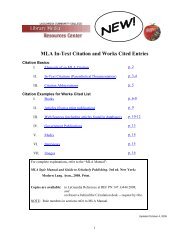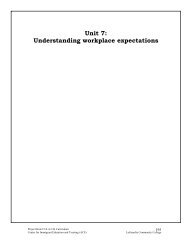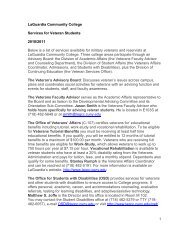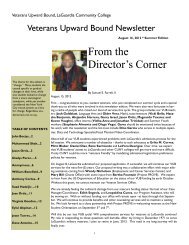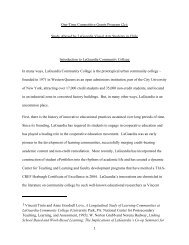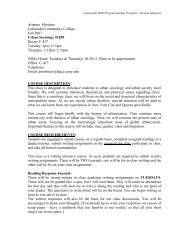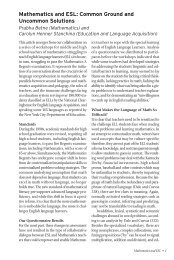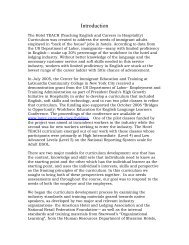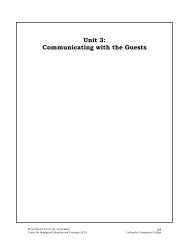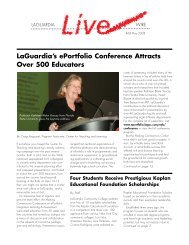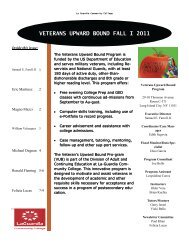Japanese courses brochure - LaGuardia Community College - CUNY
Japanese courses brochure - LaGuardia Community College - CUNY
Japanese courses brochure - LaGuardia Community College - CUNY
You also want an ePaper? Increase the reach of your titles
YUMPU automatically turns print PDFs into web optimized ePapers that Google loves.
Study <strong>Japanese</strong> @ <strong>LaGuardia</strong> Comm. <strong>College</strong><br />
Liberal Arts Social Science and Humanities <strong>Japanese</strong> Option<br />
<br />
For more information, please contact:<br />
Tomonori Nagano, Ph.D.<br />
Assistant Professor, Education and Language Acquisition Dept.<br />
<strong>LaGuardia</strong> <strong>Community</strong> <strong>College</strong><br />
31-10 omson Avenue (B-234FF)<br />
Long Island City New York 11101<br />
Tel: 718-482-5484<br />
tnagano@gc.cuny.edu / tnagano@lagcc.cuny.edu<br />
Class Homepage: http://faculty.lagcc.cuny.edu/tnagano/<br />
Education and Language Acquisition Department<br />
<strong>LaGuardia</strong> <strong>Community</strong> <strong>College</strong> (Room B-234)<br />
Tel: 718-482-5460 / Fax: 718-482-6032<br />
website: http://www.lagcc.cuny.edu/ela/ml/<br />
e-mail: tnagano@lagcc.cuny.edu<br />
Printed on: Saturday, November 16, 2013 (Tomonori Nagano)
Why you should study <strong>Japanese</strong><br />
e <strong>Japanese</strong> language is one of the most popular modern languages in the U.S. and the<br />
number of college students studying <strong>Japanese</strong> is on increase. (10.3% in 2006-2009 according<br />
to Furman et al., (2010)). New York, especially Manhattan and Queens, has a high density<br />
of <strong>Japanese</strong> language learners and a recent survey by MLA shows that more than<br />
50,000 people are currently learning <strong>Japanese</strong> in Queens.<br />
e <strong>Japanese</strong> culture is undoubtedly a major attraction to those learners. <strong>Japanese</strong> food,<br />
such as sushi and ramen, has become a popular choice among New Yorkers. Most college<br />
students in the U.S. have played <strong>Japanese</strong> video games in their youth (or even now) and<br />
have gone to karaoke to hang out with their friends. e pop-culture, including anime and<br />
TV drama, is another major interest among <strong>Japanese</strong> language learners. In addition to<br />
these contemporary culture, Japan has rich traditions and classical literature, such as karate<br />
and judo (<strong>Japanese</strong> martial arts), e Tale of Genji (classical novel written in the 11th century),<br />
and nihonga (classic <strong>Japanese</strong> fine art) to name a few.<br />
e <strong>Japanese</strong> language class at <strong>LaGuardia</strong> CC, with many extracurricular <strong>Japanese</strong> cultural<br />
activities, will provide you with not only the foreign language skill but also a deep appreciation<br />
about the <strong>Japanese</strong> society and culture.<br />
* Furman, N., Goldberg, D., and Lusin, N. (2010). Enrollments in languages other than English in United States<br />
institutions of higher education, fall 2009. Technical report, Modern Language Association, New York, NY.<br />
<strong>Japanese</strong> & Japan-related <strong>courses</strong> at <strong>LaGuardia</strong> <strong>Community</strong> <strong>College</strong><br />
<strong>LaGuardia</strong> <strong>Community</strong> <strong>College</strong> offers the following <strong>Japanese</strong> or Japan-related <strong>courses</strong>.<br />
• Elementary <strong>Japanese</strong> 1 (ELJ101)<br />
• Elementary <strong>Japanese</strong> 2 (ELJ102)<br />
• Intermediate <strong>Japanese</strong> 1 (ELJ103)<br />
• Intermediate <strong>Japanese</strong> 2 (ELJ104)<br />
• <strong>Japanese</strong> for Heritage Students (ELJ105)<br />
• Modern <strong>Japanese</strong> Literature (ELJ201; taught in <strong>Japanese</strong>)<br />
• <strong>Japanese</strong> Literature in Translation (ELJ250; taught in English)<br />
• e Art of Eastern Asia (HUA191)<br />
• East Asian Civilization and Societies (SSH110)<br />
Text and reference books for ELJ101-ELJ104<br />
Hatasa, Y. A., Hatasa, K., and Makino, S. (2009b). Nakama 1A, Introductory <strong>Japanese</strong>: Communication, Culture,<br />
Context. Houghton Mifflin, Boston, Mass., 2nd edition. ISBN: 9780618966288; Course: ELJ101<br />
Hatasa, Y. A., Hatasa, K., and Makino, S. (2009c). Nakama 1A: Student Activities Manual. Houghton Mifflin,<br />
Boston, Mass., 2nd edition. ISBN: 9780618965700; Course: ELJ101<br />
Hatasa, Y. A., Hatasa, K., and Makino, S. (2009d). Nakama 1B, Introductory <strong>Japanese</strong>: Communication, Culture,<br />
Context. Houghton Mifflin, Boston, Mass., 2nd edition. ISBN: 9780547208404; Course: ELJ102<br />
Hatasa, Y. A., Hatasa, K., and Makino, S. (2009e). Nakama 1B: Student Activities Manual. Houghton Mifflin,<br />
Boston, Mass., 2nd edition. ISBN: 9780547208633; Course: ELJ102<br />
Hatasa, Y. A., Hatasa, K., and Makino, S. (2010a). Nakama 2. Heinle and Heinle, Boston, Mass., 2nd edition<br />
edition. ISBN: 9780547171647; Course: ELJ103, ELJ104<br />
Hatasa, Y. A., Hatasa, K., and Makino, S. (2010c). Nakama 2 Student Activities Manual (SAM). Heinle and<br />
Heinle, Boston, Mass. ISBN: 9780547171708; Course: ELJ103, ELJ104.<br />
Text and reference books for ELJ105<br />
Miura, A. and Hanaoka-McGloin, N. (2008a). An Integrated Approach to Intermediate <strong>Japanese</strong> Workbook.<br />
The Japan Times, 2nd edition edition. ISBN: 9784789013086; Course: ELJ105; Price: 1,575 yen.<br />
Miura, A. and Hanaoka-McGloin, N. (2008b). An Integrated Approach to Intermediate <strong>Japanese</strong>. The Japan<br />
Times, 2nd edition edition. ISBN: 9784789013079; Course: ELJ105; Price: 3,360 yen.<br />
Oka, M. (2010). Tobira: Power Up Your KANJI: 800 Basic KANJI as a Gateway to Advanced <strong>Japanese</strong>. Kuroshio<br />
Publishers, Tokyo, Japan. ISBN: 9784874244876; Course: ELJ105<br />
Text and reference books for ELJ201 & ELJ250<br />
Goossen, T. W. (1994). The Oxford book of <strong>Japanese</strong> Short Stories. Oxford University Press, Oxford, UK, 2nd<br />
edition. ISBN: 9780802150585; Course: ELJ250; Price $16.95<br />
Keene, D. (1994). Anthology of <strong>Japanese</strong> Literature: From the Earliest Era to the Mid-Nineteenth Century.<br />
Grove Press, New York, NY, 2nd press edition. ISBN: 9780802150585; Course: ELJ250; Price $16.95.<br />
Keene, D. (1994b). Modern <strong>Japanese</strong> Literature: From 1868 to the Present Day. Grove Press, New York, NY, 2nd<br />
edition. ISBN: 9780802150950; Course: ELJ250; Price: $15.95.<br />
More about the <strong>Japanese</strong> language <strong>courses</strong><br />
<strong>LaGuardia</strong> <strong>Community</strong> <strong>College</strong> offers a two-year long <strong>Japanese</strong> language <strong>courses</strong>. See<br />
http://bit.ly/course_schedule for the schedule of <strong>Japanese</strong> <strong>courses</strong>. e proficiency goal in<br />
each of the <strong>Japanese</strong> language <strong>courses</strong> is as following:<br />
1 6<br />
Printed on: Saturday, November 16, 2013 (Tomonori Nagano)
SOCIAL SCIENCE<br />
3 CREDITS<br />
Select one from the following:<br />
SSA100 Introduction to Anthropology<br />
3<br />
SSA101 Cultural Anthropology<br />
3<br />
SSE105 International Economics<br />
3<br />
SSE125 World Geography<br />
3<br />
SSH105 World History from Ancient Times to 1500<br />
3<br />
SSH106 World History from 1500 to the Present<br />
3<br />
SSP200 Global Politics<br />
3<br />
SSH103 Western Civilization from Ancient Times to the Renaissance<br />
3<br />
SSH104 World Civilization from the Renaissance to Modern Times<br />
3<br />
SSH110 East Asia Civilization and Societies<br />
3<br />
SSH231 Afro-American History<br />
3<br />
SSH232 Survey of Latin American and Caribbean History<br />
3<br />
SSH220 Politics of Latin America and the Caribbean<br />
3<br />
SSH100 Introduciton to Sociology<br />
3<br />
[Note] Students who wish to transfer to Queens <strong>College</strong> are advised to take SSH110 East Asia<br />
Civilization and Society, which will count toward the EAS major at QC (=History 112:<br />
Introduction to East Asian History)<br />
UNRESTRICTED ELECTIVES<br />
6 CREDITS<br />
Unrestricted electives 6<br />
Total Credits: 60<br />
Interested in LA SSH <strong>Japanese</strong> Option?<br />
If you are interested, please contact Prof. Tomonori Nagano at 718-482-5484 or<br />
tnagano@lagcc.cuny.edu.<br />
ELJ101: Elementary<br />
<strong>Japanese</strong> I<br />
ELJ102: Elementary<br />
<strong>Japanese</strong> II<br />
ELJ103: Intermediate<br />
<strong>Japanese</strong> I<br />
ELJ104: Intermediate<br />
<strong>Japanese</strong> II<br />
ELJ105: <strong>Japanese</strong><br />
for Heritage<br />
Students<br />
ELJ201: Modern<br />
<strong>Japanese</strong> Literature<br />
Recommended for:<br />
Those without any previous<br />
knowledge of <strong>Japanese</strong><br />
Those with previous <strong>Japanese</strong><br />
instruction for about 50 hours;<br />
Good command of Hiragana, Katakana,<br />
and basic vocabulary (adjective<br />
and verbs)<br />
Those with previous <strong>Japanese</strong><br />
instruction for about 100 hours;<br />
Good command of the <strong>Japanese</strong><br />
characters (about 50 basic kanji)<br />
and verb/adjective conjugation (teform<br />
and plain form)<br />
Those with previous <strong>Japanese</strong><br />
instruction for about 150 hours;<br />
Knowledge of basic vocabulary<br />
and some basic sentence structures<br />
(e.g., -teiru, -ta-koto-ga aru,<br />
-sou etc.).<br />
Students who speak <strong>Japanese</strong> as a<br />
heritage language (e.g., those who<br />
were born in the U.S. between<br />
<strong>Japanese</strong> parents and completed<br />
their formal education in English).<br />
Heritage speakers of <strong>Japanese</strong><br />
who may use or hear <strong>Japanese</strong> as<br />
their home language<br />
Proficiency Goal<br />
Students can talk and write about themselves<br />
and basic everyday activities;<br />
ACTFL OPI Novice Mid<br />
Students can describe food, hometown,<br />
family members in more complex sentence<br />
structures, and talk and write about<br />
basic activities in the past. About 50 kanji<br />
characters; ACTFL OPI Novice Mid-High<br />
Students can describe weather, annual<br />
events, health, and travel plans, and can<br />
talk and write about various activities in<br />
complex sentence structures. About 75-<br />
100 kanji characters; ACTFL OPI Novice<br />
High; JLPT N5<br />
Students can describe, make requests, ask<br />
favors, and explain procedures. Students<br />
can write a substantial amount of <strong>Japanese</strong><br />
(400-600 characters) given a topic that<br />
has been covered in class; ACTFL OPI<br />
Intermed Low; JLPT N4<br />
Students will learn <strong>Japanese</strong> vocabulary<br />
and structures used in professional and<br />
educational registers, including honorific<br />
(meshiagaru) and humble (itadaku) forms<br />
of verbs. ACTFL OPI Advanced to Superior;<br />
JLPT N1 or N2.<br />
Students will be acquainted with various<br />
<strong>Japanese</strong> pragmatics through the reading<br />
and writing about the <strong>Japanese</strong> literature<br />
with using kanji characters on the Joyokanji<br />
list.<br />
ELJ250: <strong>Japanese</strong><br />
Literature in<br />
Translation<br />
No knowledge of <strong>Japanese</strong> language<br />
is required.<br />
See http://faculty.lagcc.cuny.edu/tnagano/docs/japaneseCoursesProficiencyGoals.pdf for more information about<br />
the ACTFL OPI Proficiency levels. Also, see Kondo-Brown, K. (2010). e results of <strong>Japanese</strong> ACTFL Oral Proficiency<br />
Tests (2008-09 AY). for more information about expected proficiency levels in the <strong>Japanese</strong> <strong>courses</strong>.<br />
NA<br />
For more information<br />
Visit our program website at http://faculty.lagcc.cuny.edu/tnagano and<br />
http://www.lagcc.cuny.edu/ela/ml/<br />
5 2<br />
Printed on: Saturday, November 16, 2013 (Tomonori Nagano)
Liberal Arts Social Science and Humanities: <strong>Japanese</strong> Option<br />
e Liberal Arts SSH <strong>Japanese</strong> Option is a major for those who wish to major in Japan Studies<br />
(e.g., East Asian History, East Asian Civilization, Asian Art, <strong>Japanese</strong> Linguistics etc.) at a<br />
four-year institution upon their graduation from <strong>LaGuardia</strong> <strong>Community</strong> <strong>College</strong>. is option<br />
is currently articulated with the East Asian Studies major at Queens <strong>College</strong> with the<br />
following admission requirements:<br />
• Graduation from <strong>LaGuardia</strong> <strong>Community</strong> <strong>College</strong> with an AA degree and a GPA of 2.75<br />
or better,<br />
• A grade of “B” or better in each <strong>Japanese</strong> language course taken at <strong>LaGuardia</strong> (ELJ101,<br />
ELJ102, ELJ103, and ELJ104)<br />
• A completed application to the Department of CMAL at Queens <strong>College</strong>,<br />
• Completion of 12 credits taken at Queens <strong>College</strong> with GPA of 2.75 or better in their first<br />
semester at QC.<br />
e Liberal Arts SSH <strong>Japanese</strong> Option will be offered under the Pathways framework starting<br />
in Spring 2014. Below is the curriculum for the option.<br />
JAPANESE OPTION CORE<br />
ELJ103 Intermediate <strong>Japanese</strong> 1<br />
ELJ104 Intermediate <strong>Japanese</strong> 2<br />
ELJ250 <strong>Japanese</strong> Literature in Translation<br />
Select one from the following:<br />
ELC101 Elementary Modern Chinese 1<br />
ELC102 Elementary Modern Chinese 2<br />
ELC103 Intermediate Modern Chinese 1<br />
ELC105 Modern Chinese for Heritage Students<br />
ELC201 Modern Chinese Literature (taught in Chinese)<br />
ELC202 Contemporary Chinese Literature (taught in Chinese)<br />
ELC203 Classic Chinese Literature (taught in Chinese)<br />
ELK101 Elementary Korean 1<br />
ELK102 Elementary Korean 2<br />
ELK103 Intermediate Korean 1<br />
ELK201 Modern Korean Literature (taught in Korean)<br />
[Note] One Chinese or Korean language course depending on the<br />
placement score. ELC101 and ELK101 are not paired with the 102-level<br />
course for <strong>Japanese</strong> Option students.<br />
12 CREDIT<br />
3<br />
3<br />
3<br />
3<br />
3<br />
3<br />
3<br />
3<br />
3<br />
3<br />
3<br />
3<br />
3<br />
3<br />
LA SSH: <strong>Japanese</strong> Option Curriculum<br />
COURSE & TITLE<br />
<strong>CUNY</strong> PATHWAYS REQUIRED CORE<br />
English Composition<br />
ENG101 Composition I<br />
ENG102 Writing rough Literature<br />
Mathematical and Quantitative Reasoning<br />
MAT107 Mathematics and the Modern World<br />
MAT112 <strong>College</strong> Algebra with Modeling<br />
MAT118 Introductory Statistics<br />
Life and Physical Sciences<br />
SCB101 Topics in Biological Science<br />
SCC101 Topics in Chemistry<br />
SCP101 Topics in Physical Science; or<br />
SCP140 Topics in Astronomy<br />
CREDITS<br />
12 CREDITS<br />
6<br />
3<br />
3<br />
COUNSELING<br />
New Student Seminar<br />
ENGLISH<br />
3 CREDITS<br />
ENG103 Research Paper 3<br />
LIBERAL ARTS<br />
3 CREDITS<br />
LIB200 Humanism, Science and Technology 3<br />
HUMANITIES<br />
Select one from the following:<br />
HUA101 Introduction to Art<br />
HUC106 Public Speaking<br />
HUC150 e Art of Film<br />
HUM101 Introduction to Music<br />
HUN195 Art in New York<br />
HUP101 Introduciton to Philosophy<br />
HUP104 Ethics and Moral Issues<br />
HUA191 e Art of Eastern Asia<br />
<strong>CUNY</strong> PATHWAYS FLEXIBLE CORE<br />
18 CREDITS<br />
1. Six three-credit <strong>courses</strong>. At least one course form each of the five areas and no more than two<br />
<strong>courses</strong> in any discipline.<br />
2. Students without any previous instruction in <strong>Japanese</strong> are encouraged to take Elementary<br />
<strong>Japanese</strong> 1 (ELJ101) and Elementary <strong>Japanese</strong> 2 (ELJ102) as part of Flexible Core for the LA<br />
<strong>Japanese</strong> Option.<br />
3. One Flexible Core course must be an Urban Studies course.<br />
World Cultures and Global Issues (ELJ101 & ELJ102) 6<br />
[Note] Students who wish to transfer to Queens <strong>College</strong> are advised to<br />
U.S. Experience in its Diversity 3<br />
take HUA191 e Art of Eastern Asia, which will count toward the EAS<br />
Creative Expression 3<br />
major at QC (=Art History 114: Survey of Asian Art).<br />
Individual and Society 3<br />
Scientific World 3<br />
3 4<br />
Printed on: Saturday, November 16, 2013 (Tomonori Nagano)<br />
3 CREDITS<br />
3<br />
3<br />
3<br />
3<br />
3<br />
3<br />
3<br />
3



